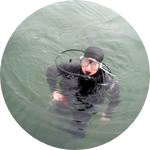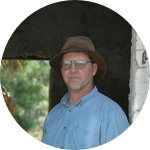About This Project
Caretta caretta (loggerhead sea turtle) is a globally threatened species. The Georgia DNR relocates some nests for conservation management, yet we don't fully understand how a multitude of environmental factors may affect success of nests which is critical for successful sea turtle conservation and management. I will evaluate how temperature, moisture, vegetation, flooding, elevation, and dune orientation affect success of loggerhead nests on Ossabaw Island, Ga.
Ask the Scientists
Join The DiscussionWhat is the context of this research?
While working on St. Catherines Island, Ga, which relocates almost 60% of loggerhead nests, I noticed that some nests relocated to high dunes (apparent prime locations for incubation) had low hatch success while other nests located 5-10m away had hatch successes in the 80-100% range. After endless sweaty hours of relocating eggs to 'better' locations, to see these nests completely fail during incubation was disheartening. I hypothesized that temperature and moisture--the two factors credited with success in nest incubation--can't be the only things controlling success on these beaches. The current 'higher-nest-higher-success' thought behind management now may become outdated as temperatures increase, and other factors may be more important in determining hatch success.
What is the significance of this project?
This project will help us better understand how temperature, moisture, vegetation, tidal flooding, elevation, and dune morphology interact to impact hatch success (proportion of hatched to unhatched eggs in each nest). Management protocols call for the relocation of nests which are at risk of tidal flooding. While current relocation protocol moves nests to the highest nearby dunes, some studies suggest that with climate change, these nests at high elevations may be getting too hot. Because so many nests are relocated, it is important to move them to locations which have the best chance of success. By improving our knowledge about other environmental factors which could impact nest success, we can update management practices to lead to more successful relocated nests.
What are the goals of the project?
We hope to better incorporate multiple environmental factors that impact hatch success into predictive models using an AIC modeling method to determine which combination of factors is most important in determining hatch success. These models can be used to predict hatch success in environments where nest placement will experience a variety of these factors (eg. nests placed in high elevation, high vegetation, and high temperatures; low elevation, no vegetation, intermediate temperatures). I will work with the Georgia DNR to update loggerhead management for the state of Georgia. Hopefully this will result in better allocation of resources and increase overall success of nests.
Budget
Data loggers (Onsetcomp) record temperature during incubation are placed in each nest I sample. I have 74 loggers currently (hoping to eventually get up to 100 via various funding sources). Loggers were lost due to Hurricane Irma and need to be replaced in order to have sufficient sample size.
Mason line (Forestry Suppliers) attaches data loggers to the nest stakes so they don't get washed away.
Flagging tape (Forestry Suppliers) helps identify nest locations along the beach.
9 V batteries (Amazon) used to power a moisture meter which is used to analyze moisture in each nest during throughout incubation.
Living Beaches of Georgia and the Carolinas (Amazon) book used to identify vegetation found near/on loggerhead nests.
Other items not listed in this budget have been purchased already (used during year one sampling) or are borrowed from other labs.
Endorsed by
 Project Timeline
Project Timeline
This project began in May 2017. Data were collected daily from May-September throughout the nesting and hatching season for loggerheads in Georgia. Data collection will resume again in May 2018 and continuing until the last nest is analyzed (usually end September). After September 2018, data from the two nesting seasons will be analyzed. This will be part of a Master's thesis and will also be published in relevant journals.
May 04, 2017
Began data collection for 2017 season
Sep 08, 2017
Ended data collection for 2017 season (ended early due to Hurricane Irma)
Oct 16, 2017
Project Launched
May 01, 2018
Begin data collection for 2018 nesting season
Sep 30, 2018
End data collection for 2018 nesting season
Meet the Team
Team Bio
This project is supported with the invaluable help of two DNR technicians. Kyle has a degree in wildlife management, but this is his first project working with sea turtles. Jack previously worked with olive Ridley sea turtles in Costa Rica. This team was hired by the DNR to work on Ossabaw where I'm collecting data. Together we're able to collect data from the island which accounts for ~15% nests in the state of Georgia.
Mattie Jean Whitesell
I began working with loggerhead sea turtles in 2015 as an undergraduate summer internship. Waking up at 04:30 and working in hot, sweaty, bug-infested conditions became something I looked forward to every day. Even though this work is physically and mentally strenuous, I am happier doing this than any other job I've had. While protecting and relocating nests, I realized that there is so much we don't know about this species and its populations. Current management practices advise the relocation of at-risk nests (eg. nests laid below high tide lines) to more viable locations--typically on dunes with high elevation. However there is some preliminary data that suggest that temperatures on these high dunes may get too high for successful incubation. In the state of Georgia, we spend a lot of time and money moving turtle nests around, so it's important to better understand what is impacting the success of these nests especially in the face of changing climates.
It amazes me that we can see such variation in nests and their resulting hatch success. This species has persisted for millions of years, and they're very adaptive when it comes to finding a place to put their nests. However humans are changing their nesting environments very quickly, and we need to understand how to facilitate the proliferation of this incredible species.
Project Backers
- 21Backers
- 109%Funded
- $948Total Donations
- $45.14Average Donation


